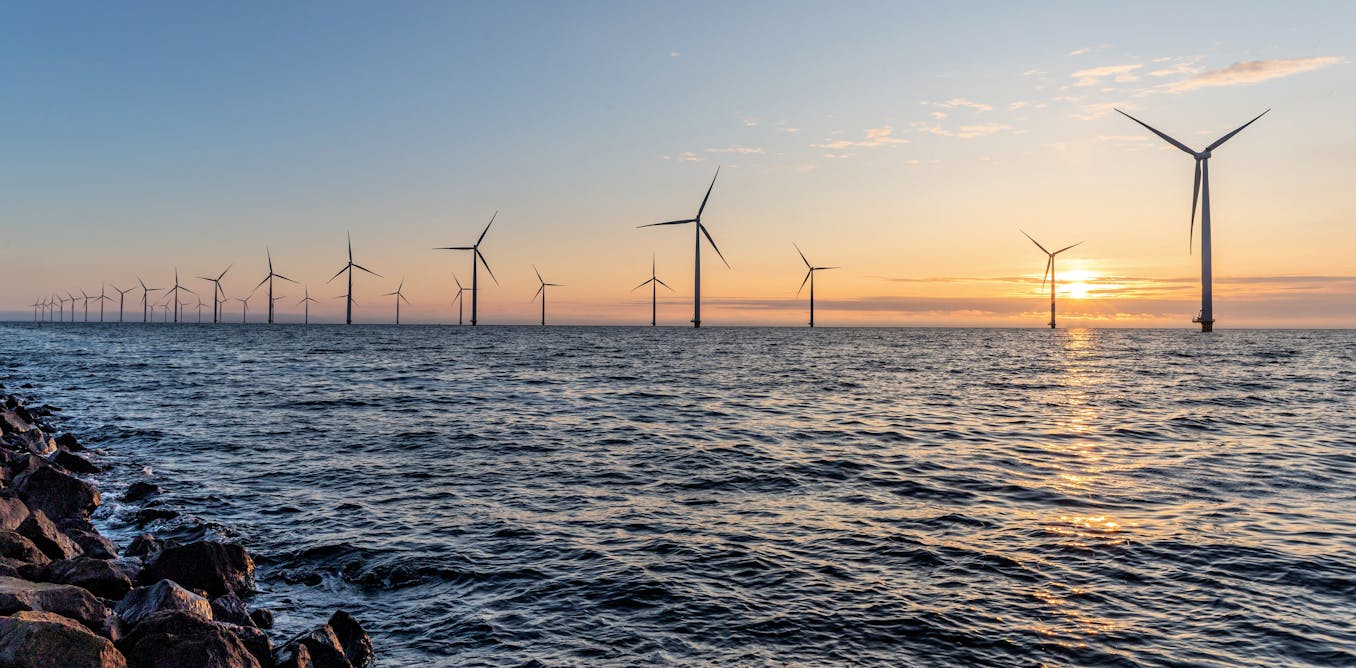Enough Red Tape – We Need To Say Yes to Clean Energy | Rich Powell | TED
The video “Enough Red Tape – We Need To Say Yes to Clean Energy” by Rich Powell is a powerful and urgent call to action for the environmental community and policymakers to remove barriers and embrace clean energy solutions. Powell shares a personal experience from his college years, where he was inspired by a clean energy project called Cape Wind. This project aimed to bring offshore wind turbines to the coast of Cape Cod to supply clean electricity to hundreds of thousands of homes. However, despite public support, Cape Wind faced opposition from wealthy coastal landowners, leading to regulatory hurdles and delays.
Powell highlights the broader issue of regulatory challenges and NIMBY (Not In My Backyard) opposition hindering clean energy projects across the United States and globally. He emphasizes the need for a shift in mindset from saying “no” to new projects to saying “yes” to clean energy solutions. Powell emphasizes the role of balanced environmental regulations but calls for environmentalists to support and advocate for all types of clean energy projects, including nuclear energy and carbon dioxide pipelines.
Furthermore, he urges the election of local officials who support clean energy and the modernization of processes for approving new clean energy projects. Powell’s talk is a timely reminder of the urgency to accelerate clean energy deployment and overcome regulatory obstacles to achieve significant emissions reductions in a rapidly shrinking timeframe. It serves as a wake-up call for individuals, policymakers, and industry leaders to work together in driving the transition to clean energy.
Watch the video by TED
When I was a junior in college, from the back row of a darkened auditorium, I listened to the CEO of a clean energy developer describe an amazing new technology that could produce a lot of clean electricity and reduce a lot of emissions. It was a project called Cape Wind,
An audacious plan to drive 130 massive offshore turbines to the coast of Cape Cod, Massachusetts, supplying enough clean electricity to supply more than 300,000 homes and eliminate the need for a mid-sized emitting power plant. It was one of those moments that inspired me to a career in clean energy and climate policy.
Now, in the 20 years since that night, we could have built literally thousands of those turbines up and down the US East Coast. But instead, we have built literally six total turbines in the US East Coast. And that’s because a combination of wealthy coastal landowners, both liberals and conservatives,
Don’t like those turbines spoiling the views from their sunset cocktail parties. Who knew they could agree on anything? Now Cape Wind had broad public support. More than 80 percent of Massachusetts residents were in favor, probably because they realized that siting the turbines 12 miles offshore makes them barely even visible to the naked eye. But the project was stymied, using regulations designed by environmentalists to protect the environment,
Instead used by a wealthy few to protect their views. Tragically, Cape Wind is far from unique. Regulations and lawsuits have been used to slow down or stop hundreds of clean energy projects in this country, from renewables like geothermal to solar to hydro, to new nuclear plants, to pipelines carrying captured carbon dioxide,
To new transmission lines. Many of those projects have been killed, many others are still stuck in permitting purgatory. Now there is some good news. Recently, alumni of Cape Wind have teamed up with a massive global energy developer and are finally going to put steel in the water
Off the coast of Massachusetts later this year. But only after overcoming, I quote, “countless regulatory hurdles.” To take a step back, we have many of the technologies, the engineers, even the policies to drive down global emissions and solve the climate challenge. But what keeps me up at night
Is that government red tape combined with NIMBY — that’s “not in my backyard” — opposition will get in the way. Now like, literally right now, government needs to get out of the way and let the private sector build clean energy. And as for the rest of us environmentalists, we all need to say a lot more “yes” than “no” in the coming decades, so free enterprise can get out there and do the hard part. Now, you’re probably getting the sense that I’m not your typical environmental warrior.
I’m not a socialist or a member of a Green Party. I love being in nature, but I don’t own any Birkenstocks. I can see that free markets deploy clean capital faster than any other force on the planet, which makes calls for degrowth or ending capitalism deeply irresponsible to both environmental progress
And human flourishing. I run an American clean energy non-profit organization called ClearPath. We advance policies that accelerate innovations to reduce and remove global energy emissions. We spend a lot of time understanding clean, reliable, 24/7 energy systems. In order to build those, we’ve got a lot of work to do in very little time.
For starters, we have to transform the American power system. Now, all roads to net-zero emissions in the United States start with making this system 100 percent clean. But then, because we have to electrify so much more of our economy, this system will need to at least double in size, maybe much more.
Now it took 125 years to build the system we have today. And if you’re like me, targeting 2050 for net zero, means we have to accomplish that in the next 27 years. That translates to 10,000 new clean energy projects just in the US just this decade. And every single one of those projects
Starts with a permit to build. Now, tragically, in the US, since the 1970s, well-intentioned policy makers and environmental leaders have designed a world-class apparatus for getting in the way. Let me give you an example. NEPA, which I promise is the only boring legal acronym I will use today,
Stands for the National Environmental Policy Act. NEPA was passed in the 1970s with the intention to get developers to understand the environmental impact of their projects, and to show that they had considered lower impact alternatives. Makes a lot of sense. But NEPA was passed before the modern Clean Air,
Clean Water or Endangered Species Acts. And, crucially, NEPA gives outside stakeholders the right to sue over government regulatory decisions. And now wealthy outside stakeholders use NEPA suits to slow down and kill clean energy. Regionally, things are also in gridlock. Did you all know that here in Detroit, this beautiful electricity system
Is managed by a massive supergrid that procures electricity from independent generators all over the Midwest, and moves that electricity to factories and cities and homes through a power market? Sounds great right? The problem is the line to connect a new clean energy plan into that power market
Now extends to almost four years nationwide, and at the state and local level, elected officials are also putting up walls to specific kinds of clean energy. In the US, 12 states still have some kind of a moratoria on new nuclear energy, for example. Now, I will let somebody else do the talk
On the amazing benefits of nuclear energy. But suffice it to say that putting 24/7 clean, reliable energy off limits doesn’t make a lot of sense. And we now have low-income communities across the country also voicing opposition to new clean energy projects, which is understandable because they have borne the brunt of environmental pollution in the past. So now we have communities across the country, rich and poor, all saying no instead of yes. This movement goes well beyond NIMBYism.
Some folks have called it BANANA-ism. That’s “build absolutely nothing anywhere near anything.” Sad, sad. And this isn’t just a problem in the United States. In Germany, there’s been opposition to new offshore wind, even as they’re shutting down their nuclear fleet for ideological reasons, and you’re getting a sense of how I feel about that. There’s also been opposition to new wind in Norway,
While Australia has banned new nuclear, even as they’ve said they wouldn’t shut down new coal. The list goes on around the world. Now I have just painted a pretty gloomy picture, and most folks who know me know that I am a sunny optimist. So here’s the part where we get to begin anew
With the end in mind. It starts by realizing there is a very important role for balanced environmental regulation. Here in the US, we all benefit from the Clean Water Act, passed at a time when our heavily polluted Cuyahoga River literally caught on fire. But the solution to our permitting emergency
Begins with all of us environmentalists. We all need to support new build and retrofit clean energy projects of all kinds, regardless of whether they’re things we’ve been specifically for in the past. Carbon dioxide pipelines aren’t so bad to look at, especially compared to the impacts of climate change that they’re meant to mitigate.
And this seems trivial, but developers need to do their part to make their projects more visually appealing. Just look at the way these advanced nuclear developers have reimagined their designs to incorporate nature and welcome in the local community. We all need to elect local officials that support new build clean energy,
And reject regulations that get in the way. At the regional level, we need to encourage those supergrid operators to modernize their processes. They could review applications systematically in clusters rather than one at a time. Doing that could save two years from the average project timeline, and making that change could rapidly bring
A terawatt of new energy generation into the US system, the vast majority of it clean. That would go a long way towards that doubling of the grid. All clean. Lastly, we need to encourage our federal policymakers, Congress and the administration, to reform the rules that govern our national environmental laws.
In 2005, during an energy crisis, we actually made it really easy to permit new oil and gas production on public lands in the United States to improve energy affordability. Why don’t we give clean energy developers the same kind of leeway now during this great national challenge? We should automatically permit some classes of clean energy that have very little local environmental impact. Think a new solar site or nuclear plant on a brownfield site, like a retired coal plant. We can audit them later to make sure that they’re compliant with environmental laws.
And for those projects that do have significant environmental impact, let’s make sure that their reviews are done in a year or less, that the lawsuits are brought in three months or less, and that we adjudicate those suits in six months or less. Doing that alone could shave five to 10 years
Off of project timelines nationwide. Other countries serious about building clean have already started to make some of these reforms. Spain, for example, has eliminated those up-front environmental statements for some classes of clean energy, and they saw projected installations increase 20 percent in a matter of months. To put it simply,
If we’re serious about getting to net zero anytime soon and solving the climate challenge, let’s get to yes. Green light. Approved. Yes in my backyard. Tens of thousands of times all over the world. Let’s get building. Thank you.
About TED
The TED Talks channel features the best talks and performances from the TED Conference, where the world’s leading thinkers and doers give the talk of their lives in 18 minutes (or less). Look for talks on Technology, Entertainment and Design — plus science, business, global issues, the arts and more. You’re welcome to link to or embed these videos, forward them to others and share these ideas with people you know.
Video “Enough Red Tape – We Need To Say Yes to Clean Energy | Rich Powell | TED” was uploaded on 01/15/2024 to Youtube Channel TED




































